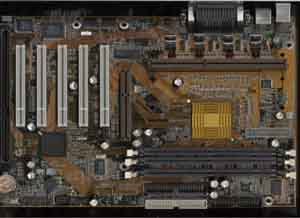Next Generation Motherboard Platforms - Part 1: The Athlon Craze
by Anand Lal Shimpi on September 29, 1999 11:58 PM EST- Posted in
- Motherboards
Gigabyte's GA-7IX
The 7IX was the first non-AMD manufactured Athlon motherboard to enter our labs and, while we expected nothing but the best from Gigabyte (considering their previous track record), the 7IX was a tad disappointing. Keep in mind that the 7IX board we received was revision 0.4, well beyond the shipping revision and obviously a beta motherboard, so we can't criticize Gigabyte based on stability or performance problems associated with the board.
The design of the 7IX very closely resembles the Fester, which can be considered to be the "reference" Athlon motherboard design, simply because it is a tested design that works. The three DIMM slots are organized in the same manner on the 7IX as they are on the Fester, with the first DIMM slot separated from the last two by a gap about half a centimeter wide.
The ATX power supply connector is placed across from the third DIMM slot (the one closest to the AMD 751 North Bridge) just like on the Fester and the North Bridge is covered by a standard BX heatsink. The one major difference between the 7IX and the Fester is the lack of any heatsinks on the voltage regulators that run adjacent to the Slot-A connector. This does make dissipating the heat off of the voltage regulators a bit more difficult but, we could not attribute any instability issues to this factor.

The same four toroidal inductors are used on the 7IX but while the Fester featured the nichicon capacitors on the motherboard, the 7IX boasted the cheaper Choyo caps. Once again, no noticeable points of instability were attributed to this discrepancy in the two designs, but it is obvious that the 7IX is more optimized for price than the Fester.
The 7IX is definitely more expansion friendly than the Fester, seeing as it makes use of the 5/2/1 expansion slot configuration (PCI/ISA/AGP). There are a total of three fan connectors on the motherboard, monitored by the Winbond 851AB chip which also drives the two thermistors on the board, one placed beneath the Athlon's heatsink next to the Slot-A connector and the other placed next to the floppy drive connector.
 A unique feature of the 7IX, and
definitely one that you'll see on future motherboards, is the inclusion of an 8-pin front
panel USB connector for USB ports to be placed at the front of your case. The 7IX also
provides for a chassis intrusion detection jumper for use with cases that support this
function.
A unique feature of the 7IX, and
definitely one that you'll see on future motherboards, is the inclusion of an 8-pin front
panel USB connector for USB ports to be placed at the front of your case. The 7IX also
provides for a chassis intrusion detection jumper for use with cases that support this
function.
A problem we had with the 7IX and one we've continuously seen reported about Gigabyte motherboards is the ability to deliver enough current to the AGP slot for certain graphics cards (i.e. TNT2 Ultra). We noticed similar problems with the 7IX during our testing, which may or may not have been corrected since the production of our board, that basically limited the stability of TNT2 cards that drew 6A of current (i.e. TNT2 Ultra boards clocked at frequencies greater than 150/183).
 The 7IX features no
adjustable FSB settings however, the motherboard had two settings silk screened onto the
PCB although neither of them were able to be taken advantage of. The 90MHz and 100MHz FSB
settings were displayed on the PCB but the two jumpers that correspond to those settings ,
JP7 & JP8, are both hammered down.
The 7IX features no
adjustable FSB settings however, the motherboard had two settings silk screened onto the
PCB although neither of them were able to be taken advantage of. The 90MHz and 100MHz FSB
settings were displayed on the PCB but the two jumpers that correspond to those settings ,
JP7 & JP8, are both hammered down.
The Award BIOS setup on the 7IX provides for very few configuration options in comparison to the slew of memory and processor configuration options we're used to seeing, especially on boards such as the ABIT BX6 Revision 2 and the latest ABIT BE6-II, considered to be two of the top tweaker motherboards. The phrase that comes to mind when looking at the BIOS setup of the 7IX is "it works and that's it" which is the closest you can get to completely explaining it's BIOS setup in five words.











0 Comments
View All Comments